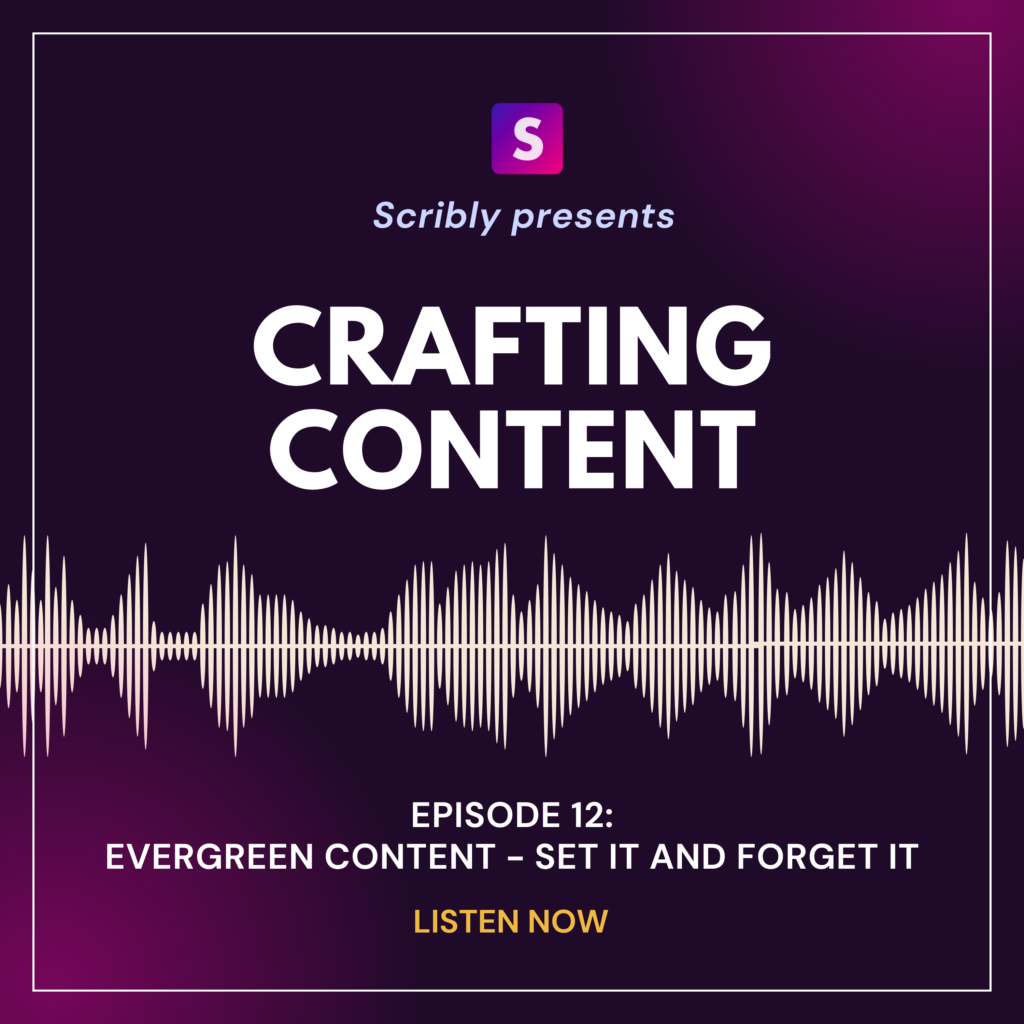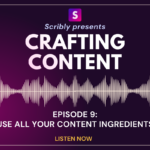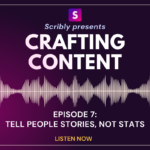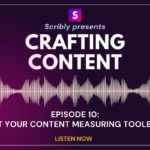Crafting Content, Episode 12 – Evergreen content – set it and forget it
Crafting Content Episode 12: Set it and forget it
Welcome to another episode of Scribly’s “Crafting Content” podcast! In today’s episode, we discuss evergreen content – what it is, how to create it, and how to keep it updated over time.

You can listen to the full episode here: Scribly’s Content Marketing Podcast Episode 12: Evergreen content, set it and forget it
Episode 12: Evergreen content – set it and forget it [transcript]
Taylor: Hello and welcome to another episode of Crafting Content, the Scribly podcast. Today I’m joined again by Alex and Elle, and we are going to be talking about evergreen content. What it is, why you want it, how to do it, all that stuff. So let’s get started. What is evergreen content? Let’s start with the basics.
Alex: Evergreen content is what it sounds like. It’s basically content that you can produce that doesn’t have a lifespan on it. In our example or in our context, I suppose, as a content marketing agency, we’d be talking about written content that you can put on your blog or on your website that will continue to provide value for customers or your audience or whoever you’re hoping will read the stuff you’re putting out.
Obviously, everything on the Internet is, in a way, evergreen. Because if someone doesn’t take it down, if I don’t take it down, if I post something on my blog, it’s just there. But the difference between any old blog post and something that we would describe as evergreen content is that it’s still providing value, it’s still driving traffic. People can search for it and it will be relevant to them a year after you first published it, two years, however long.
So, for example, something like a how to guide on how to do something specific like produce evergreen content or something like that would be a good example because I could post that this year, and then someone two years down the line can Google “how to produce evergreen content” and they’ll find the guide that I’ve written and it’s still going to be relevant and they’re still going to click on it.
As opposed to something like if we put out a blog talking about the latest update in Google Analytics. If someone then searches for that in two years time, and Google Analytics has had ten updates since then, they’re not going to want to read about Google Analytics update 1.1 when we’re now on 1.9. So in that way, that’s not evergreen. Even though it still exists online, people aren’t going to keep going to that piece of content further down the line, I suppose.
Elle: Thanks, Alex. That makes it a lot easier to understand, particularly when you’ve got a counterexample there. Both of the examples you gave were kind of blog based. Evergreen content is something which stands the test of time. Can other types of content be evergreen?
Alex: Yeah, definitely. So it’s not just blogs that could be evergreen. There’s all sorts of stuff. And of course other types of content as well, which we’re not going to deal with too much, but video and audio content, that can all be evergreen too.
But in terms of written content specifically, there’s all sorts of things. So like a product review for example. If you’re reviewing a new set of headphones that have come out, that review is going to be relevant for as long as the headphones exist. It might decrease in time, but if someone’s still trying to buy that same pair of headphones five years down the line, it’s still going to be relevant to them.
Things like FAQs on common topics have the potential to be evergreen as well. if the information or the subject hasn’t changed, it’s still going to be helpful for people. Something like a glossary that’s covering industry specific terms and things like that. Capex is probably always going to mean the same thing as it does now. So if you’ve got a glossary explaining that, it doesn’t matter if you wrote it this year, five years ago, ten years ago, it’s still going to be relevant to someone who’s trying to figure out “what does capex mean?”.
Elle: So what you’re essentially saying is that evergreen content is something which stands the test of time. It will always add value. We understand the value of evergreen content from a user perspective — tey’re always going to be able to find the information that they’re looking for and it’s going to be a useful resource for them. But from a company’s perspective of actually creating that content, what’s the benefit of focusing on an evergreen strategy?
Alex: Good question. I think the benefit really comes down to efficiency or the time investment required because you can write a 1000-word ultimate guide on whatever it may be, then it’s kind of a one and done type deal.
If you’re focusing on evergreen content because you write it, of course you make sure it’s SEO optimized and all of that good stuff. That goes without saying, but once it’s done, it’s done and you can pop it up and just leave it. The whole point is that because it’s going to remain relevant and because it’s SEO optimized, it’s going to continue to drive traffic for you into the long run without you needing to be updating it or constantly adding new content. It’s just something you can put up and leave.
Having said that, it is still important to check how it’s performing over time and potentially to update it if you need to. So it’s still a case of it will have some effort on your end. It’s not just write it and post it. I mean, you can do, but if you want to get the best out of it, it’s still important to have a look to see how it’s performing, because maybe it’s actually not what your audience is looking for, or maybe there have been some slight changes and it means that you can just make sure that it’s as relevant as possible. But again, it’s far less effort to update a section in a guide you’ve already written than to write a whole new guide because there’s been some tweak to Google’s algorithm or whatever it might be. So I think the main benefit is that you can get a lot of bang for your buck.
Elle: Almost every website you look at has one strong blog that seems to drive at least half of all of its organic traffic. And it’s usually something that’s been online for three, four years. It’s built that authority. We’ve got one which is all about copywriting examples, and it’s been live more or less since we were founded. And it just keeps bringing the traffic in because as you say, it’s a relevant piece and they’re relevant examples that can still be applied today. It just helps build our authority for all our other pieces and keep that traffic flowing. You made a really interesting point about whether or not you needed to update evergreen content and I would like to come back to that.
If you wanted to give a company some advice as to how to create an evergreen focused content strategy, where do they start?
Alex: For sure. So I think the first place to start is to research, really, and figure out what exactly you want to do. So what kind of content you want to produce and what is going to be the most relevant to your audience specifically. So first you need to kind of figure out in your niche what might be valuable because there are different types of evergreen content. Like we said, you could do a glossary, say, or you could do a product review, or you could do an ultimate guide to x. So you need to spend the time figuring out what is going to be the most valuable to your audience, what they’re actually going to engage with, and how you can provide value to the people you’re looking to target.
There’s no sense in putting out a glossary of industry terms if no one’s going to click on it, because no one needs to know the industry terms about DVD players or whatever it might be. If your audience is looking for how to set up my DVD player with my new TV, then that’s going to be far more relevant than “What is a laser scanner”. I think that the first step is figuring out what your audience is actually going to be looking for and what’s going to provide them with the most value.
A good way of doing that, of course, is to look at what competitors are doing. That can be helpful. Although if one of your competitors got a very, very good performing blog on “How do DVD players work”, maybe you could target something else. But I think that the first step is figuring out exactly what you’re going to do and why you’re going to do it.
Elle: Obviously people understand their own industry because they work in it. But sometimes people have assumptions, because they’re almost too familiar with it, and maybe a term or blog post isn’t actually super relevant for the end user. So, where would you go to find out that information? Do you search for words on Google and look at the “people also asked” section> Do you use a keyword research tool? Where are you finding that information to make those decisions?
Alex: Yeah, I think, keyword research would be a big one. So you want to see what people are searching for in your area or in your niche, because again, there’s no sense in putting out evergreen content that’s not going to drive any traffic because no one’s searching for it and no one has any interest in it. G
Google Analytics would be another good place to go to see how existing pages are performing. Are people engaging with it? Are there some topics or areas that are driving more traffic for you already? Because that might be somewhere to double down on.
Again, going back to the DVD player example, if you’ve got blogs on DVD players and Blu ray players and the DVD player ones are driving way more traffic for whatever reason, then that might be an obvious place for you to focus rather than producing a piece of evergreen content around Blu ray players. So yeah, I think looking at keywords, looking at Google Analytics.
Elle: And using that to, as you say, build out clusters based on core themes that you’ve identified, things that work well, long tail keywords that you might need to answer in a glossary. DVD player is a really hard example.
Alex: Yeah, sorry, I don’t know why I picked DVD players.
Elle: I think it’s because you’ve been working on a client who works in that industry. But if we’re talking about that kind of industry, you know, there might be questions around different types of tapes, DVD recording equipment, can I play a DVD on an Xbox or PS5?
Taylor: So you’ve kind of built out those clusters in Google Analytics. Can you see the search terms that people use that have ended them up on your site?
Elle: You can do that in Search Console.
Taylor: Search console?
Elle: Yeah, in Google search console, it essentially tells you what keywords are driving what traffic to your website, and it tells you how many clicks and how many impressions you have. Impressions being the number of people who’ve seen your listing based on that keyword.
So, say you’re a content marketing agency and someone types in “what is content marketing?” If you’ve got a blog post about that and 1000 people see it, that gives you 1000 impressions. And if out of those 1000 people, 100 actually click through and read your article, that gives you 100 clicks. So you can see from there what types of keywords are driving traffic.
Taylor: So if people are ending up on your site based on searches for certain things or a certain category of things that you don’t necessarily have tons of content on yet, that might be something to look at to be like well we can kind of fill that gap and then maybe keep them on our site longer or give them more of what they’re actually looking for.
Elle: Yeah. The likelihood is it’s reverse engineering that. So if they’re finding your website through certain keywords, the likelihood is that you perform well for those keywords already. And actually it’s using that to say “these are the keywords that we already know we do well for” and then, having done the research Alex ran us through earlier, “these are all the other evergreen terms which we’d like to see more traffic come in through”. And you can cross reference those two tools to identify the gaps that you’ve got.
Either double down on what’s already working, as Alex suggested, or identify the gap and go after those. And then you can use your keyword ranking tools and your Google Search Console to see if your efforts are paying off. Are people now finding your websites through those gaps that you identified?
Okay, so Alex, let’s assume that you’ve done your research, you’ve built out your clusters, you know what topics you want to go after, you know what people are interested in reading, what’s the next step?
Alex: The next step is to write it — which sounds silly, but it is really. The important thing, like we mentioned earlier, is that because it’s an evergreen piece of content, it’s got to be SEO optimized. If it’s going to continue to drive traffic long into the future, it needs to have the ability to drive traffic in the first place.
So just like any other blog post you write, you want to make sure you’re optimizing it with keywords, doing meta descriptions, all of that fun stuff that we’ve spoken about on this podcast.
And then obviously along with that is then to publish it and market it or promote it. Let people know that you’ve published a new piece of content. Because, yeah, it really is just like any other blog post, you want to get eyes on it initially. Even if the plan is that this is going to be something that serves you over the next few years, you still want to be able to push people towards it initially. But then one of the beauties of evergreen content is you can publish it today and put it out on your socials. And then in six months you can say “check out this blog post we wrote” because it’s still relevant. It’s still going to be useful for people to engage with, even though it’s old at this point. So these are the next steps: writing it, publishing it, letting people know that it’s there.
Taylor: When you’re writing a piece of evergreen content, are there certain things that you should avoid doing that you would maybe be doing when you’re writing other kinds of content?
Alex: Yes. I think perhaps it would be wise to avoid things that could end up making it too dated or referring to things that are very specific and kind of time bound, maybe. So if you’re talking about current events that could end up leaving it dated, if you are covering a new software update that’s just come out, maybe avoid that and speak in more general terms, rather than saying “in this specific new update from Spotify, x, y, and z”. I think it’s just trying to avoid things that are going to date it, that are going to lessen its relevance further down the line.
Elle: That’s a great question. I was thinking about links. We often back things up by linking to credible sources. So, we might have a piece of research that says “on average, it takes eight touch points to convert a consumer off the back of your content marketing efforts”. And, we’ll link that statistic to whatever reports just came out. But it might be that in two years time, that is no longer eight, it’s 18. Or we’re still linking to an article from 2019 and now it’s 2024 and it’s five years old, and that can date it. But I still think you want to bring that authority with you.
So I think it’s what you were talking about, Alex, earlier. Yes, evergreen content should rank highly for SEO and drive that traffic consistently. But you do need to revisit it, even if it’s only every six months, every year, just to update a few bits here and there to ensure that it stays relevant.
Taylor: When I’m looking at a piece that’s supposed to be timeless, I look at the sources that we’re linking out to and who’s likely to keep this piece online for an extended period of time. McKinsey, Deloitte, maybe Harvard Business review, those big hitters of research who are more likely to keep this server running and keep stuff up online for an extended period of time than some smaller sources. So that’s kind of something to consider as well.
Elle: Yeah. And the likelihood is that they’ll also understand the value of SEO content. So let’s say, that they were the ones to release that statistic about eight touch points. Two years down the line, they do a new research piece which finds it’s twelve touch points. They’re likely to just update their own article. So it means that the link that you’re linking to is still the right source and still relevant. You just need to update a small bit of copy, because you know that they’re doing their updates as well.
Alex: But I think that highlights an important point just in terms of the next steps for when you’re creating evergreen content. Don’t just forget about it. You need to still be monitoring how it’s performing, if it’s performing, if it’s not driving any traffic. Is there an obvious reason? Maybe your SEO stuff’s a bit off or maybe the information has become outdated. So yeah, it is important to remember to keep looking at it.
Taylor: You want to keep checking your rotisserie chicken cooker regularlyI have a metaphor for this, please.
Elle: Oh, I love a good metaphor.
Taylor: And now maybe I’m dating myself to not be so evergreen here, but like, I don’t know if this is a particularly American thing either, but the old infomercials for the “set it and forget it” rotisserie chicken cookers, you guys ever see those?
Alex: No.
Elle: Link to it in the show notes so people can look it up.
Taylor: I think it was Ron Popille who used to do these, and it’d be like you put your whole chicken in the rotisserie chicken maker and you set it and forget it. And you could walk away for 4 hours. And you’d come back and your chicken was done, but, like, you also don’t want to leave the house while you’ve got this kitchen gadget running. So, you want to keep checking that it’s still working, it’s still cooking the chicken, it’s not burning your house down. So in the same way, you want to check that everything’s published correctly, it’s driving some kind of traffic. If it’s not, maybe you change the seasoning, the keywords, if you will.
Elle: I’m loving this metaphor.
Alex: Yeah, these are great.
Elle: Fabulous.
Taylor: And then at the end of the cooking time, maybe six months in content time, you check and see what the end result is. And if you need to make some adjustments to how your rotisserie chicken cooker is set up, then you go and do that and carry that forward. Not just for the evergreen content that you already have, but for your next chicken, for your next evergreen content.
Elle: Yeah, I feel like we should just applaud you.
Alex: I was just about to say that. Yeah. Little clap.
Taylor: Something’s come over me this morning. Maybe I’m hungry.
Alex: Think about them chicken.
Taylor: I just like, the concept of evergreen content to me is always so associated with that set it and forget it phrase. And I don’t know if that’s just because I was raised by TV, but, like, that’s what I think of.
Elle: I feel like it’s a great place to end.
Alex: Yeah, can’t top that.
Elle: Cool. I think we leave it on Taylor’s beautiful metaphor.
Alex: Yeah, for sure.
Taylor: Beautiful, juicy, golden brown. Yeah. So I guess we’ll leave the evergreen content discussion there and we’ll see you again in another episode.
Thank you for listening to Crafting Content, a content marketing podcast from Scribly. You can find more information about what we cover today in our show notes. Scribly is a content marketing agency that helps you boost traffic, generate sales, and increase your bottom line. With our end-to-end service, we take care of everything from content audits and strategy to content creation and management across websites, blogs, socials and email. We’re a small but mighty team of experienced strategists and marketers who specialize in content creation. If you want to learn more about how Scribly can help your business, please get in touch. You can find more information and send us a message on our website, scriblymedia.com. We’d love to hear from you.




